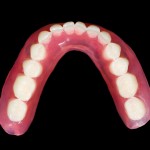
Mandibular overdentures are an effective approach to rehabilitation of the edentulous mandible. Retention can be achieved using splinted or non-splinted attachments. Ball attachments are the most commonly used non-splinted attachment but recently the stud type attachment is becoming more popular as it has been reported to provide a higher retention force and lower incidence of fracture than the ball type.
The aim of this review was to compare the clinical performance and self-reported patient outcomes of ball and stud attachments as mandibular overdenture retainers.
Methods
A protocol for the review was registered on the PROSPERO database. Searches were conducted in Medline/PubMed, Cochrane, Scopus, Web of Science, Latin American and Caribbean Health Sciences Literature database (LILACS), Embase, OpenGrey, Proquest, Google Scholar and ClinicalTrials.gov and ReBEC (Brazilian Registry of Clinical Trials). Randomized (RCTs) and nonrandomized (N-RCTs) clinical trials comparing mandibular overdentures retained with stud attachments and mandibular over-dentures retained with ball attachments were considered. Primary outcomes were implant survival rate, bleeding on probing (BoP), marginal bone loss (MBL), and patient-reported outcome measures (PROMs). secondary outcomes included prosthetic maintenance and complications. Three reviewers independently screened and selected studies, extracted data and assessed risk of bias using the Cochrane risk of bias tool (RoB 2) or risk of bias in nonrandomized studies of interventions (ROBINS-I). Meta-analyses were conducted, and certainty of the evidence assessed using the grading of recommendations assessment, development, and evaluation (GRADE) instrument.
Results
- 17 studies (8 parallel RCTs, 5 cross-over RCTs,4 N-RCTs) involving a total of 586 patients (987 implants were included.
- All 8 parallel RCTs and 4cross-over -RCTs were considered to be at high risk of bias.
- One N-RCT had a critical risk of bias and 3 a serious risk of bias.
- Implant survival rate was similar for ball and stud attachments RR= 0.99 (95%CI; 0.97 to 1.02)
- For prosthetic maintenance analyses,
- ball and stud attachments presented similar risk for reline RR= 1.78 (95%CI; 0.84 to 3.80)
- but ball attachments presented a higher risk for matrix activation than stud attachments RR= 7.12(95%CI; 2.65 to 19.15)
- For prosthetic complications
- mandibular overdentures retained with ball and stud attachments presented similar risk
- for prothesis fracture RR= 2.06 (95%CI; 0.93 to 4.57).
- tooth fracture RR =2.00(95%CI; 0.38 to 10.58).
- loss of male component RR= 3.25(95%CI; 0.43 to 24.47).
- replacement of the attachment RR= 0.80 (95%CI; 19 to 3.33).
- matrix replacement RR= 4.30 (95%CI; 0.86 to 21.41)
- Ball attachments presented a higher risk for prosthesis replacement (new overdenture) than stud attachments RR= 2.47 (95%CI; 1.02 to 5.96)
- Implants that received ball attachments were associated with increased mean MBL for up to 1 year (MD= 0.40 (95%CI; 0.28 to 0.52) and 5 years follow-up (MD= 0.18 (95%CI; 0.16 to 0.20).
- Implants that received ball and stud attachments had a similar mean BoP up to 1 year MD= 0.07 (95%CI; 0.13 to 0.28).
- Patient satisfaction using a visual analog scale (VAS) was higher in patients with mandibular overdentures retained by stud than by ball attachments SMD= -1.1 (95% CI; -1.65 to -0.67),
- 6% (n=18) of patients tested with both attachment systems reported that they preferred the stud attachment, with 43.2% preferring the ball attachment, and 8.1% reporting no preference between systems.
- OHRQoL data showed that patients using mandibular overdentures retained with ball and stud attachments presented a similar means at different time points up to 1 year.
Conclusions
The authors concluded: –
-
Stud and ball attachments are clinically appropriate options as mandibular overdenture retainers and are capable of restoring OHRQoL. Nevertheless, the stud type showed a greater improvement in patient satisfaction as it required less prosthetic aftercare and was associated with lower MBL at 1 and 5 years.
-
As the certainty of the evidence was low for most of the outcomes, further studies of high quality are needed to improve confidence in these conclusions.
Comments
A 2018 Cochrane review (Dental Elf – 17th Oct 2018) looked more widely at attachment systems for maxillary and mandibular implant overdentures identifying 6 RCTs and concluding at that time that there
is insufficient evidence to determine the relative effectiveness of different attachment systems on prosthodontic success, prosthodontic maintenance, patient satisfaction, patient preference or costs.
This new review focuses more narrowly on comparing two different retention systems for mandibular overdentures. While a number of new studies have been published since the Cochrane review the quality of the available evidence is limited with almost all the studies being included in the review assessed as being at high risk of bias. For most of the outcomes assessed in the review there was little difference between the two attachment systems. However, for some of the outcomes only a small number of studies were included and the limited quality of the available studies suggest that the findings should be viewed cautiously. As the authors of the Cochrane review and this review has indicated there is a clear need for high-quality well conducted trials in this area. For despite improvements in dental health in many countries there are still significant numbers of edentate patients who require effective treatments.
Links
Primary Paper
Girundi ALG, Ribeiro MCO, Vargas-Moreno VF, Borges GA, Magno MB, Maia LC, Del Bel Cury AA, Marcello-Machado RM. Patient-reported outcome measures and clinical performance of implant-retained mandibular overdentures with stud and ball attachments: A systematic review and meta-analysis. J Prosthet Dent. 2022 Aug 2:S0022-3913(22)00089-0. doi: 10.1016/j.prosdent.2022.02.006. Epub ahead of print. PMID: 35931572.
Other references
Dental Elf – 21st Mar 2022
Implant-supported overdentures and fixed prostheses in edentulous mandibles
Dental Elf – 10th Feb 2020
Overdentures: The effect of attachment systems on clinical performance
Dental Elf – 17th Oct 2018
